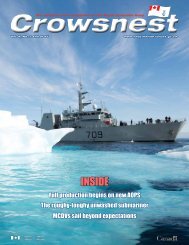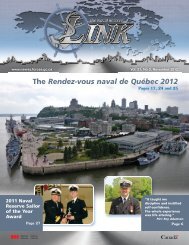You also want an ePaper? Increase the reach of your titles
YUMPU automatically turns print PDFs into web optimized ePapers that Google loves.
coast guard can sometimes provide greater flexibility to policymakers than would be <strong>the</strong> case<br />
were naval forces deployed. China’s reliance on its large <strong>and</strong> capable coast guard to exercise what<br />
are essentially constabulary functions in <strong>the</strong> East China Sea is one such example. It allows<br />
Beijing to avoid military-to-military confrontations. 323 Non-military competition using coast<br />
guards or maritime law enforcement vessels—e.g., between Japan <strong>and</strong> China over <strong>the</strong> disputed<br />
Diaoyu/Senkaku Isl<strong>and</strong>s—creates breathing room in times <strong>of</strong> heightened tensions, <strong>and</strong> prevents<br />
inevitable escalation that would likely follow were naval forces engaged in this form <strong>of</strong><br />
brinkmanship.<br />
For most countries, however, navies will retain an important or leading role in asserting (<strong>of</strong>ten<br />
merely through presence) legitimate national authority in both sovereign waters <strong>and</strong> within EEZs.<br />
Governments will also continue to use <strong>the</strong>ir navies as an instrument for cooperative diplomacy.<br />
Humanitarian assistance <strong>and</strong> disaster relief missions, such as those conducted in response to <strong>the</strong><br />
tsunami in East Asia (2004) or earthquake in Haiti (2010), are regularly used not only to alleviate<br />
human suffering, but are also intended to augment a country’s s<strong>of</strong>t power. 324 And, navies will be<br />
used to forge coalitions to improve regional maritime domain awareness, as in North America or<br />
among EU member-states, or to help develop essential maritime security capabilities among<br />
less-developed countries. Described as partnership-centric, <strong>the</strong> latest version <strong>of</strong> <strong>the</strong> US<br />
government’s maritime strategy, A Cooperative Strategy for 21 st Century Seapower (2015),<br />
places considerable importance on cooperative capacity building. In discussing <strong>the</strong> global role <strong>of</strong><br />
<strong>the</strong> USN it asserts, for example, that “[m]erging our individual capabilities <strong>and</strong> capacity produces<br />
a combined naval effect that is greater than <strong>the</strong> sum <strong>of</strong> its parts. By working toge<strong>the</strong>r in formal<br />
<strong>and</strong> informal networks, we can address <strong>the</strong> threats to our mutual maritime security interests.<br />
Maximizing <strong>the</strong> robust capacity <strong>of</strong> this global network <strong>of</strong> navies concept, we are all better<br />
postured to face new <strong>and</strong> emerging challenges.” 325 This is, <strong>of</strong> course, <strong>the</strong> thinking behind such<br />
USN-led multilateral exercises as Rim <strong>of</strong> <strong>the</strong> Pacific (RIMPAC) <strong>and</strong> UNITAS, <strong>and</strong> multilateral<br />
ga<strong>the</strong>rings such as <strong>the</strong> Western Pacific <strong>Naval</strong> Symposium (WPNS). Enhancing national naval<br />
capability through frequent international contact <strong>and</strong> cooperation also contributes to decisions by<br />
countries to deploy naval assets in support <strong>of</strong> allies <strong>and</strong>/or partners (e.g., <strong>the</strong> UK naval task group<br />
in <strong>the</strong> Arabian Sea). But it need not be multilateral, for governments will also use naval capacity<br />
building to advance strictly bilateral relationships. In 2007, for example, China transferred nine<br />
patrol boats to Cambodia only three months after Phnom Penh announced its intention to improve<br />
<strong>the</strong> security <strong>of</strong> its <strong>of</strong>fshore oil production facilities. <strong>The</strong> timing <strong>of</strong> this gesture was reportedly very<br />
much appreciated by <strong>the</strong> Cambodian authorities. 326 While advancing foreign policy objectives,<br />
support for maritime capacity building using navies can also be a key enabler in helping “to<br />
provide greater maritime security as a building block for greater stability on l<strong>and</strong>.” 327<br />
323 See Ryan D. Martinson, “China’s Second Navy”, Proceedings <strong>of</strong> <strong>the</strong> United States <strong>Naval</strong> Institute,<br />
April 2015, pp. 24–29.<br />
324 S<strong>of</strong>t power can be defined as “<strong>the</strong> ability to get what you want through attraction ra<strong>the</strong>r than coercion or<br />
payments. It arises from <strong>the</strong> attractiveness <strong>of</strong> a country's culture, political ideals, <strong>and</strong> policies. When our<br />
policies are seen as legitimate in <strong>the</strong> eyes <strong>of</strong> o<strong>the</strong>rs, our s<strong>of</strong>t power is enhanced.” Joseph S. Nye, S<strong>of</strong>t<br />
<strong>Power</strong>. <strong>The</strong> Means to Success in World Politics (Public Affairs: New York, 2004), p. x.<br />
325 A Cooperative Strategy for 21 st Century Seapower, p. 2. See also Sam J. Tangredi, “US Navy Efforts in<br />
Supporting Partner <strong>Maritime</strong> Capacity Building: Refocusing a Tradition”, in Forbes (ed.), <strong>Maritime</strong><br />
Capacity Building in <strong>the</strong> Asia-Pacific Region, pp. 41–52.<br />
326 Evans, “Enforcing Free Trade.”<br />
327 Trelawny, “<strong>Maritime</strong> Security Beyond Military Operations: A Civilian Perspective”, p. 51.<br />
68 DRDC-RDDC-2016-R085




